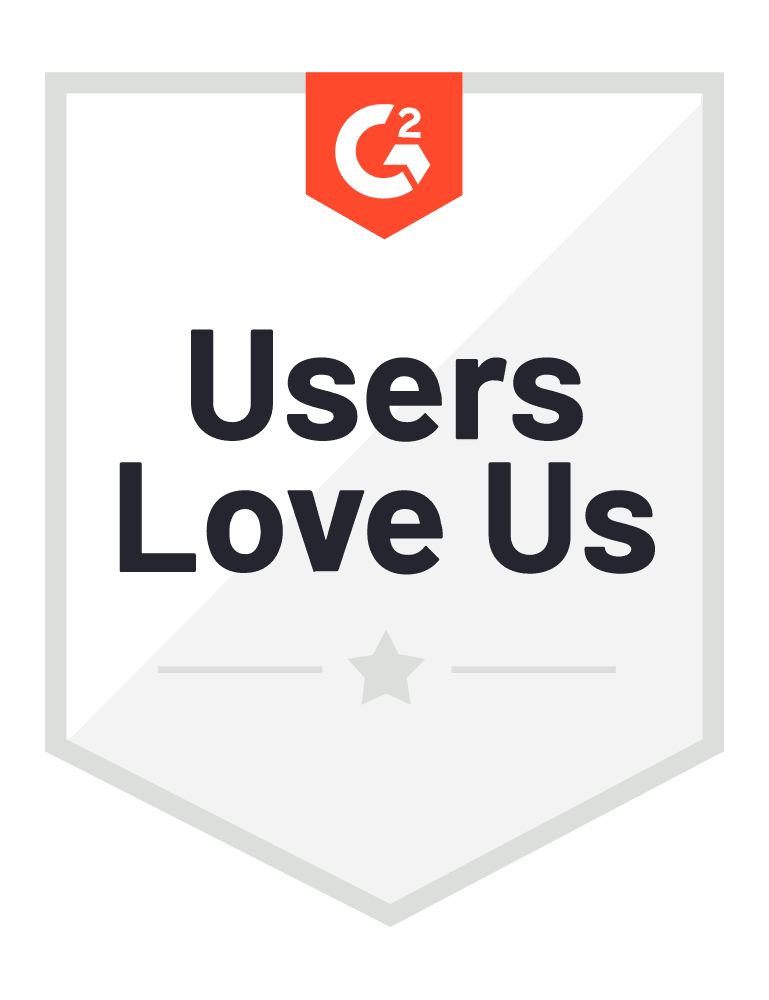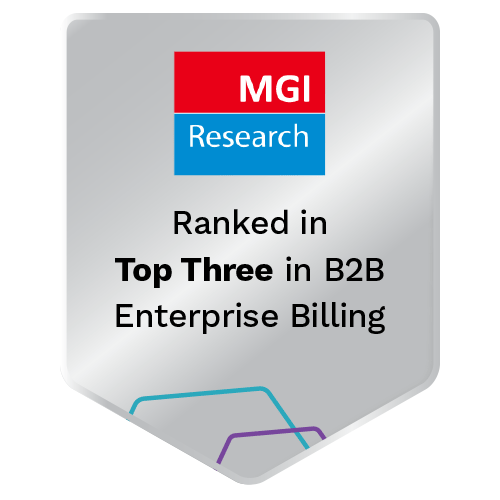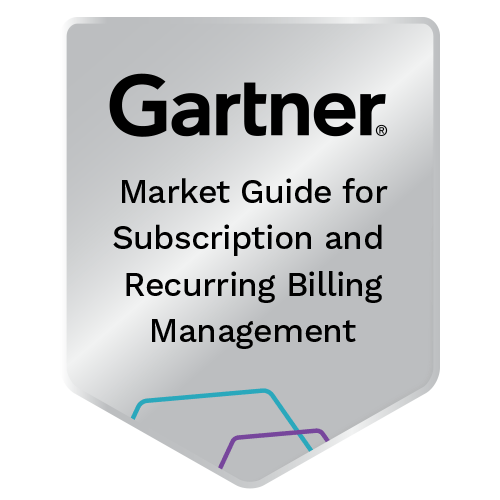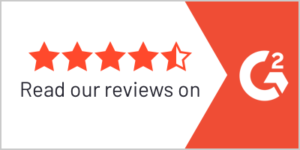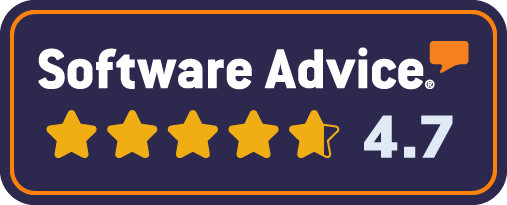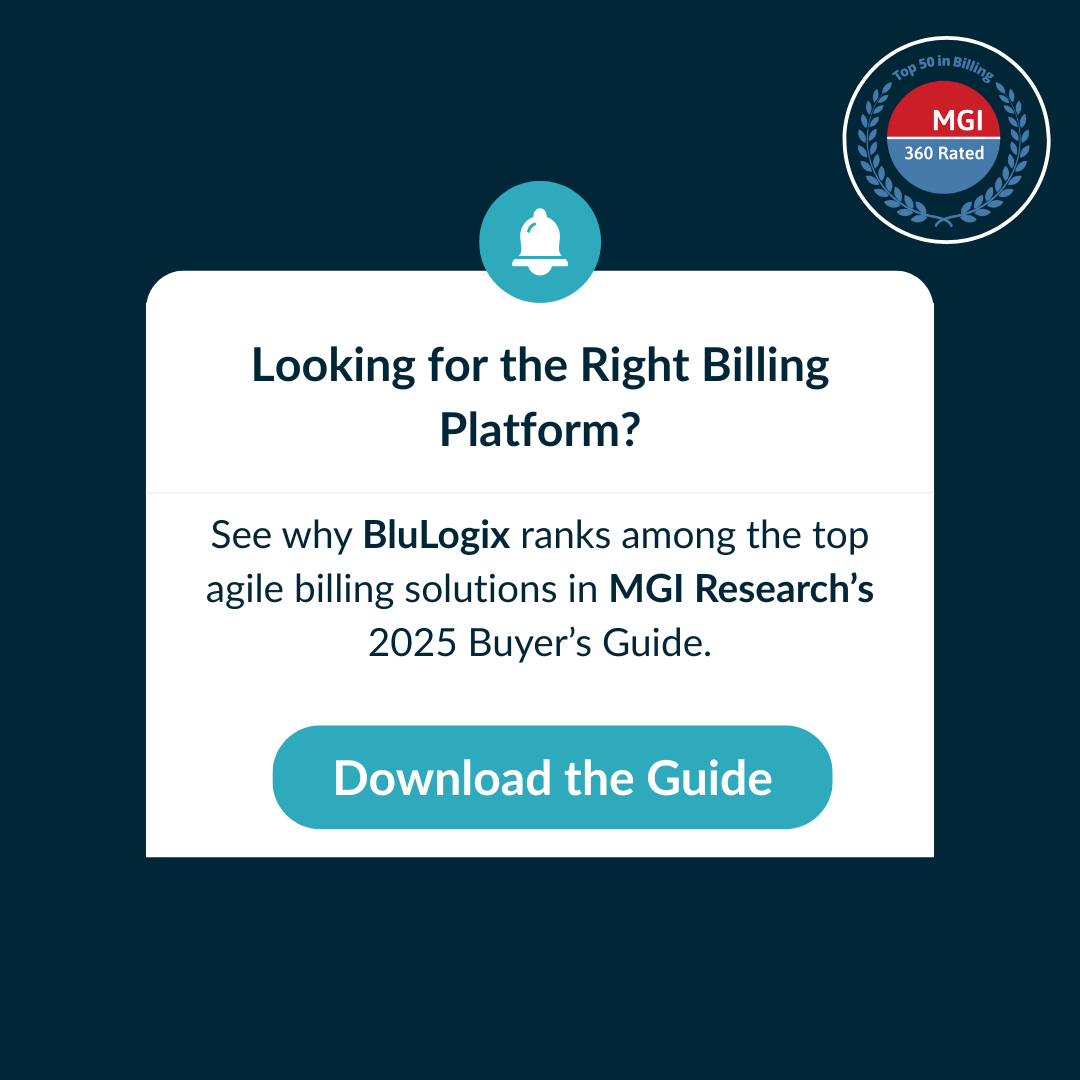Blulogix Whitepaper
IT Financial Management vs. Cost Recovery / Chargeback: A Strategic Analysis and Comparison for Modern IT Organizations
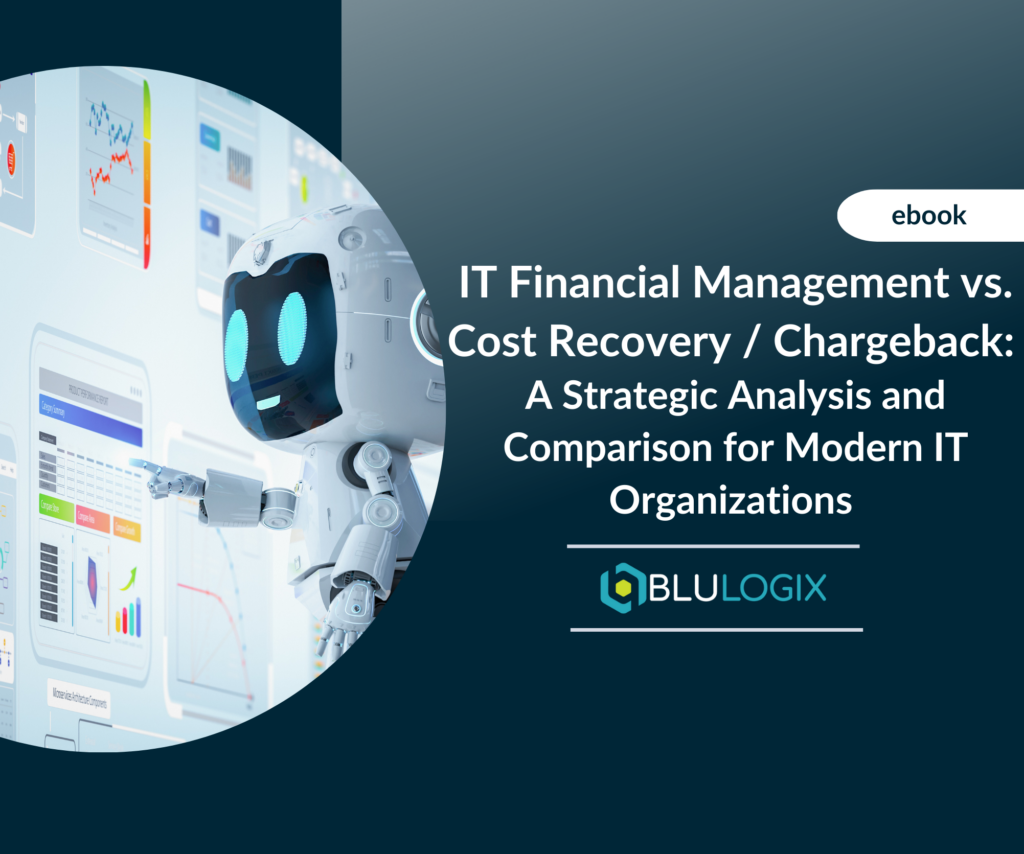
Table of Contents
Overview
As IT shifts from cost center to value enabler, financial transparency, accountability, and optimization have become top priorities. Organizations are increasingly looking to IT Financial Management (ITFM) and Cost Recovery/Chargeback frameworks to manage this transformation.
With IT becoming more and more a mission-critical function rather than just a support tool, organizations across industries must understand and control how IT costs are created, allocated, and justified.
Two of the most widely adopted frameworks—IT Financial Management (ITFM) and Cost Recovery/Chargeback—help organizations improve transparency, accountability, and value realization from IT investments.
While these models are often seen as complementary, they also serve distinct purposes and have different financial, operational, and cultural implications. This whitepaper explores how each approach serves different needs, the impact of public cloud adoption, and why combining both can unlock smarter decision-making and better cost control. We also have included a handy checklist to help you evaluate the right solution for your organization.
Strategic Context: Why Organizations Embrace ITFM and Chargeback
Complex IT ecosystems-especially in public sector, higher education, and large-scale enterprises-leaders face mounting pressure to control costs, prove value, and plan smarter.
What’s Driving This Shift?
- IT as a Service Provider: IT is no longer just a back-office function—it powers mission-critical operations.
- Increased Budget Scrutiny: Finance departments want to know not just what IT costs, but why. The growth in public cloud adoption in particular is driving the need for increased transparency.
- Cross-functional Demand: Departments, agencies, and business units are increasingly consuming IT services autonomously, negating the potential of bulk purchasing and volume discounting.
- Operational Complexity: Hybrid environments, SaaS, and cloud adoption introduce volatility and demand fine-grained cost tracking.
Whether in the public or private sector, leaders are under pressure to prove ROI, make informed investment decisions, and align consumption with cost.
The Goal: Align IT Spending with Business Value
Strategic IT financial operations aren’t just about cost-cutting—they’re about creating visibility, trust, and informed decision-making across the enterprise. That’s why organizations are turning to ITFM for planning and transparency, and Chargeback for enforcement and cost recovery.
This is where ITFM and Cost Recovery/Chargeback frameworks come into play.
Understanding the Two Models
Let’s break down what makes ITFM and Chargeback fundamentally different—yet potentially complementary.
IT Financial Management (ITFM)
A strategic planning framework designed to model, forecast, and analyze IT spending. It helps CIOs and finance leaders gain a big-picture view of IT’s cost structure.
- Definition: A strategic approach to managing the business of IT—budgets, cost models, forecasting, service costing, and showback.
- Primary Focus: Transparency, planning, cost optimization.
- Audience: Internal IT and finance leadership.
- Common Tools: TBM (Technology Business Management), Apptio, ServiceNow ITFM.
- Common Use Cases: Planning annual budgets, analyzing IT investments, tracking ROI.
Key Capabilities:
- Budgeting & Forecasting
- Service Costing: Mapping costs to IT services.
- Showback: Reporting departmental consumption without billing.
- Cost Transparency: Uncovering cost drivers to optimize spend.
- Portfolio Rationalization: Prioritizing investments.
Showback: The Soft Power of ITFM
Showback allows organizations to report IT costs back to departments based on usage, without invoicing. This educates internal consumers on their IT footprint, builds cost awareness, and promotes responsible behavior—but without financial accountability.
Limitation: Showback lacks consequences. Departments may continue over-consuming because there’s no financial impact.
Cost Recovery / Chargeback
A transactional model that allocates or bills the cost of IT services back to the consuming units. It transforms IT into a shared services provider that can manage, recover, and optimize spend.
- Definition: A financial model that allocates and bills IT costs back to consuming departments based on usage or pricing models.
- Primary Focus: Operationalize financial accountability with enforceable transactions.
- Focus Areas: Metering, rate cards, invoicing, reconciliation, ledger entries.
- Audience: Agencies, departments, and business units consuming IT services.
- Commonly Used In: Government, higher education, shared services, multi-agency IT service delivery.
- Common Use Cases: Shared infrastructure billing, cloud cost allocation, inter-agency services.
Key Capabilities:
- Usage-based Metering & Pricing
- Service Catalog & Rate Cards
- Invoice Creation & Journal Entries
- Vendor Spend Reconciliation
- Stakeholder Portals for Real-Time Visibility
- Ledger-Level Accuracy for Compliance
Putting Teeth into Chargeback
Unlike Showback, Chargeback ensures departments are financially responsible for the services they consume. This leads to:
- Better decision-making: Departments become selective and cost-conscious.
- Demand management: Eliminates waste and overprovisioning.
- Strategic planning: IT can scale based on actual need and value.
Key Strength: Chargeback puts financial responsibility in the hands of the consumers, which changes behavior and drives efficiency.
Key Differences at a Glance
When comparing ITFM and Chargeback, it’s important to recognize how each framework impacts operations, accountability, and financial governance.
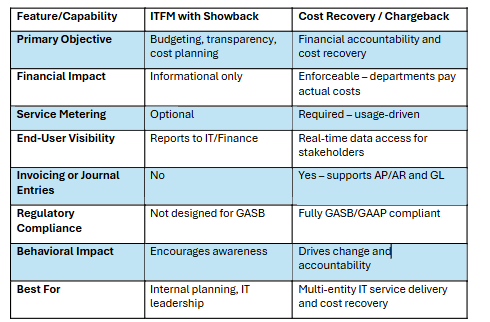
This difference is not merely technical—it changes how departments view IT. With ITFM, they’re aware of costs; with chargeback, they own them.
Expand Your Backend and Frontend Capacity
Automate, Connect, Sync: A Growth Imperative
Manual workflows, disconnected processes, and human errors are growth killers. For companies in growth mode, they are critical to eradicate as early in your trajectory as possible.
In a competitive and rapidly evolving market, automation is no longer an optional enhancement—it’s a foundational necessity for sustainable growth. Businesses that fail to align their backend operations with their customer-facing systems risk inefficiencies, missed opportunities, and reduced customer satisfaction. Automation bridges this gap, offering a scalable solution that streamlines operations, reduces risks, and supports long-term growth.
Eliminate Manual Processes
Manual processes are inherently flawed. They introduce errors, delays, and inefficiencies that limit your business’s potential. Automation eliminates these bottlenecks by streamlining critical workflows:
- Order Management: Ensuring accuracy and consistency in capturing and processing orders that enhances customer trust.
- Billing and Invoicing: Reducing errors that can damage customer relationships and delay cash flow. Error-free billing ensures cash flow and reduces disputes.
- Inventory Management: Maintaining precise stock levels and ensuring timely replenishment to prevent costly shortages or overages.
Automated workflows ensure that these critical operations are executed flawlessly, freeing your team to focus on strategic tasks rather than tedious administrative work. If your team is bogged down by repetitive tasks, you’re wasting valuable resources that could be directed toward strategic initiatives.
Speed Up Processes
Disconnected systems lead to sluggish operations. The ability to integrate backend systems with customer-facing applications enhances operational speed and responsiveness. A synchronized front and backend system accelerates key processes ensuring your business can keep up with demand:
- Order Fulfillment: Orders move seamlessly from placement to processing, ensuring fast, reliable deliveries that exceed customer expectations.
- Customer Communication: Automation ensures that customers receive real-time updates, improving satisfaction, trust and loyalty.
By removing delays and inefficiencies, businesses can meet customer expectations and stand out in a crowded marketplace. Your competitors are likely investing in speed and efficiency—can you afford to fall behind?
Reduce Risk with Built-In Logic
Mistakes aren’t just an inconvenience—they are costly and damaging to your reputation. Mistakes in order processing, pricing, or product configurations can lead to costly errors and customer dissatisfaction. By incorporating logic-based rules into workflows, businesses can “idiot-proof” their operations, ensuring:
- Preventing Configuration Errors: Automated checks ensure compatibility and completeness in orders.
- Enforcing Regulatory Compliance: Built-in safeguards ensure adherence to legal and operational standards.
This proactive approach minimizes errors and reduces the risk of revenue loss or reputational damage. If you’re still relying on manual processes prone to human error, you’re inviting unnecessary risk into your operations and there is no room for preventable mistakes in a competitive market.
Why Hiring is Not the Solution
Think hiring more staff is the answer? Think again. Increasing headcount to manage growth is inefficient and unsustainable.
- Higher Fixed Costs: Salaries, benefits, and training represent ongoing financial commitments that can drain resources.
- Longer Onboarding Periods: New hires require time to learn systems and processes, delaying their contributions and slowing down results.
- Human Error: Repetitive tasks are prone to mistakes, no matter how skilled your team is.
Automation scales with your business needs without the overhead of hiring and training additional staff. If you’re relying solely on people to solve your growth challenges, you’re already behind.
Key Takeaways
- Leverage Technology: Use automation to handle demand spikes efficiently and maintain service quality, implementing tools to manage growth without sacrificing quality or cost.
- Build Logic-Based Processes: Create workflows with embedded intelligence to eliminate bottlenecks and errors.
- Integrate Frontend and Backend: Synchronize systems to streamline operations and improve responsiveness.
- Prepare for Scalability: Invest in systems that support seamless growth without adding complexity.
By automating, connecting, and syncing backend and frontend systems, businesses can not only meet today’s demands but also build a foundation for future success.
Why GASB Compliance Matters in Chargeback
For public sector organizations, GASB compliance is more than a checkbox—it’s a legal, operational, and financial necessity.
What is GASB?
The Governmental Accounting Standards Board (GASB) establishes rules for public sector financial reporting. Key standards like GASB 34 and 35 require:
- Accurate internal cost allocations
- Full accountability in service billing
- Reconciliation of spending to the General Ledger
Why Chargeback Needs to Be GASB-Compliant
A compliant chargeback system must:
- Generate journal entries instead of informal invoices
- Support multi-agency allocations
- Integrate with government accounting systems
- Ensure audit readiness at all times
Bottom Line: Chargeback systems that aren’t GASB-compliant can’t support public sector operations at scale, putting funding, audits, and credibility at risk.
Checklist: Which Approach is Right for You?
Use this checklist to evaluate your organizational needs. Many start with ITFM and evolve to chargeback—or adopt both concurrently.
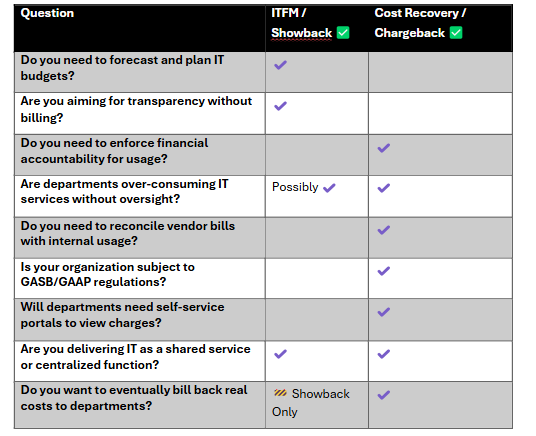
The Hybrid Opportunity: Planning Meets Enforcement
Forward-thinking organizations are leveraging both ITFM and Chargeback as part of a unified IT finance strategy.
Organizations often start with ITFM and Showback to gain visibility, then evolve to Chargeback as they mature. The right solution may be a hybrid model where:
- ITFM tools are used for planning, modeling, and cost optimization
- A chargeback engine like BluLogix provides billing, metering, and compliance
- Departments are gradually transitioned from awareness to accountability
How It Works
- ITFM provides strategic insights, helps set annual budgets, and supports CIO-level decision-making.
- Chargeback operationalizes that strategy by aligning real-time service consumption with cost accountability.
By combining both:
- Departments gain visibility and responsibility.
- IT leaders get clarity on service costs and demand trends.
- Finance receives auditable, journal-entry-ready data.
6- Hybrid is not a compromise—it’s an evolution. ITFM and Chargeback together create a full lifecycle approach from planning to billing to reconciliation.
7- The Cloud Effect: Why Public Cloud Adoption is Driving Demand for Chargeback
The rapid shift to public cloud infrastructure—by states, higher education institutions, and enterprises—has reshaped the economics of IT. Where infrastructure was once fixed and centralized, cloud services are now on-demand, elastic, and usage-based. This introduces new challenges and imperatives for IT financial management:
Why Cloud Changes Everything
- Metered Services: Cloud platforms like AWS, Azure, and Google Cloud bill by the hour, GB, or API call.
- Decentralized Consumption: Different departments spin up resources without centralized approval.
- Dynamic Costs: Costs fluctuate based on actual usage, seasonality, and unmonitored sprawl.
- Cross-Departmental Usage: Services and environments are shared, but finance needs to allocate costs accurately.
Without a chargeback model in place, IT becomes the unwitting payer of everyone’s cloud bill—resulting in budget overruns, lack of accountability, and wasted resources.
How Chargeback Enables Cloud Governance
Chargeback models bring financial discipline to cloud adoption by:
- Allocating cloud spend based on real usage
- Encouraging departments to shut down unused resources
- Making consumption visible—and billable—to the consumer
- Driving optimization through awareness and consequence
- Reinforcing FinOps principles in a structured, enforceable way
Public Sector & Education Implications
- States adopting AWS and Azure government clouds need GASB-compliant billing mechanisms to recover costs from agencies and track spend accurately.
- Universities adopting cloud-based research platforms must allocate compute/storage spend across departments, labs, and grant funding sources.
- Enterprises must align multi-cloud spend with internal business units, customer lines, and product teams for real margin analysis.
What Organizations Need
- Real-time metering and attribution
- Granular cost allocation tools
- Self-service portals for transparency
- Integration with financial systems for compliance
Bottom Line: Cloud adoption without chargeback is like an open bar with no tab—attractive at first, unsustainable long-term
Conclusion
Both ITFM and Cost Recovery/Chargeback play important roles in the financial maturity of IT organizations. While ITFM provides the strategy and insight, Chargeback enforces the economics. They’re both essential tools for financially mature, service-oriented IT organizations. Whether you need transparency (ITFM), accountability (Chargeback), or both, the time to act is now.
As cloud adoption, decentralization, and financial scrutiny increase, organizations that fail to evolve will face uncontrolled costs, poor decision-making, and limited strategic impact.
Choosing the right approach depends on:
- Your organizational structure
- Financial accountability needs
- Regulatory requirements
- Maturity of internal IT service delivery
Those who embrace the combined power of ITFM and Chargeback will unlock:
- Better planning
- Real accountability
- Optimized IT investments
- Auditable compliance
- And above all—trust between IT, Finance, and the business
Forward-thinking organizations are embracing both, enabling full lifecycle IT financial operations from budgeting to billing—and building trust between IT, Finance, and business units along the way.
About BluLogix
BluLogix bridges the gap between ITFM and Cost Recovery with a powerful, compliant platform purpose-built for public sector, higher education, and shared service organizations. Our Chargeback & Cost Recovery solution:
- Automates usage-based billing and cost allocation
- Supports GASB/GAAP-compliant journal entries
- Reconciles vendor invoices with actual service usage
- Provides real-time visibility to departments via self-service portals
- Integrates seamlessly with finance, ERP, and ITFM systems
Turn IT from a black box into a strategic growth driver.
Looking for more information? Schedule time to speak with one of our experts who can help you build your plan.
Reviews

Michael R.
President, Allnet Air Inc. - Telecommunications
Best Outsourced Billing for Mobility

Karen R.
Manager, Cloud Billing - Computer Software
BluLogix has been a great partner.
“Over the last several years, I have seen continual enhancements and additions to the platform. BluLogix has created a comprehensive solution for users. They provide great communication regarding upgrades and address concerns thoroughly and timely.”

Sara K.
Marketing, Graphic Design & Social Media Management - Marketing and Advertising
Fantastic platform. Recommend!
Industry Leaders
Reviews

Michael R.
President, Allnet Air Inc. - Telecommunications
Best Outsourced Billing for Mobility

Karen R.
Manager, Cloud Billing - Computer Software
BluLogix has been a great partner.
“Over the last several years, I have seen continual enhancements and additions to the platform. BluLogix has created a comprehensive solution for users. They provide great communication regarding upgrades and address concerns thoroughly and timely.”

Sara K.
Marketing, Graphic Design & Social Media Management - Marketing and Advertising
Fantastic platform. Recommend!

